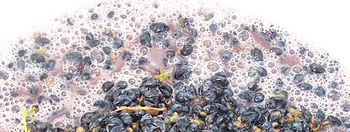**Historical Perspective and Innovations in Winemaking:**
– Fermentation observed by humans since ancient times
– Louis Pasteur’s connection between yeast and fermentation
– Discovery of the Embden–Meyerhof–Parnas pathway in the early 20th century
– Invention of the GOfermentor’s automated winemaking device in the early 2010s
– Use of different yeast strains for flavor enhancement
**Compounds and Processes in Winemaking:**
– Yeast metabolism creating compounds affecting flavor and aroma
– Production of volatile compounds like aldehydes, esters, and ketones
– Formation of non-volatile compounds like glycerol and acetic acid
– Release of glycoside hydrolase during fermentation
– Generation of volatile thiols by some yeasts for fruity aromas
– Chemical processes involving sugar-phosphate attachment and breakdown
– Conversion of sugar into ethanol and acetic acid
– Importance of nutrients and oxygen for yeast activity
– Sediment formation from exhausted yeast in fermentation tank
**Winemaking Considerations and Techniques:**
– Observation of visible carbon dioxide bubbles during fermentation
– Factors influencing ethanol production: sugar content, yeast strain, temperature
– Ideal fermentation temperatures for white and red wines
– Cooling methods to control heat during fermentation
– Addition of sulfur dioxide to correct spoilage in wines
– Various winemaking processes under fermentation
– Bottle fermentation method in spa
**Specialized Fermentation Methods:**
– Carbonic Maceration (whole grape fermentation)
– Encourages fermentation inside grape berries
– Common in Beaujolais wine production
– Involves storing grapes with replaced oxygen with carbon dioxide
– Enzymes in grapes break down cellular matter to form ethanol
– Malolactic Fermentation
– Bacteria converting malic acid to lactic acid
– Softening wine taste by reducing tartness
– Simultaneous occurrence with yeast fermentation
– Some yeast strains converting L-malate to L-lactate
**Resources and References in Winemaking:**
– Jancis Robinson’s ‘The Oxford Companion to Wine’
– H. Johnson’s ‘Vintage: The Story of Wine’
– Wine Spectator and New Jersey Monthly articles
– Analysis of yeast populations during alcohol fermentation study
– Books like ‘The Wine Bible’ and ‘Wine Science Principles and Applications’
– Wine Research Centre at UBC findings on malolactic yeast ML01, new substances risk assessment, regulatory approval, and the importance of malolactic fermentation in winemaking
The process of fermentation in winemaking turns grape juice into an alcoholic beverage. During fermentation, yeasts transform sugars present in the juice into ethanol and carbon dioxide (as a by-product). In winemaking, the temperature and speed of fermentation are important considerations as well as the levels of oxygen present in the must at the start of the fermentation. The risk of stuck fermentation and the development of several wine faults can also occur during this stage, which can last anywhere from 5 to 14 days for primary fermentation and potentially another 5 to 10 days for a secondary fermentation. Fermentation may be done in stainless steel tanks, which is common with many white wines like Riesling, in an open wooden vat, inside a wine barrel and inside the wine bottle itself as in the production of many sparkling wines.

